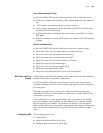BGP 127
Route Advertisement Policy
In the Switch 8800, BGP uses the following policies when it advertises routes:
■ If there are multiple routes available, a BGP speaker only selects the optimum
one.
■ A BGP speaker only advertises its own route to its peers.
■ A BGP speaker advertises the routes obtained from EBGP to all its BGP peers
(including EBGP and IBGP peers).
■ A BGP speaker does not advertise the routes obtained from IBGP to its other
IBGP peers.
■ Once the connection is set up, a BGP speaker will advertise all its BGP routes to
its peers.
Router Selection Policy
In the Switch 8800, BGP uses the following policies when it selects routes:
■ Discard the routes from an unreachable or unknown next hop.
■ Select the routes with the highest local preference.
■ Select the routes that originate at the router itself.
■ Select the routes with the lowest number of AS-paths.
■ Select the routes with the lowest origin.
■ Select the routes with the lowest MED value.
■ Select the routes learned from EBGP.
■ Select the routes advertised by the router with the lowest ID.
BGP Peers and Peer
Groups
A BGP speaker calls other BGP speakers, peers, when they exchange information.
Multiple related peers compose of a peer group.
In the Switch 8800, a BGP peer must belong to a peer group. If you want to
configure a BGP peer, you first need to create a peer group and then add a peer
into that group.
BGP peer group feature can simplify user configuration and improve route
advertisement efficiency. When added into a peer group, a peer inherits all the
configuration of the group.
If the configuration of a peer group changes, the configuration of its member
peers also changes. Some attributes can be configured to a particular member
peer by specifying its IP address. The attributes configured in this way have a
higher priority than those configured for a peer group. Note that all member peers
must use the same update policy as its group, but may use a different ingress
policy.
Configuring BGP BGP configuration includes:
■ Enabling BGP
■ Entering Extended Address Family View
■ Configuring Basic Features for a BGP Peer


















